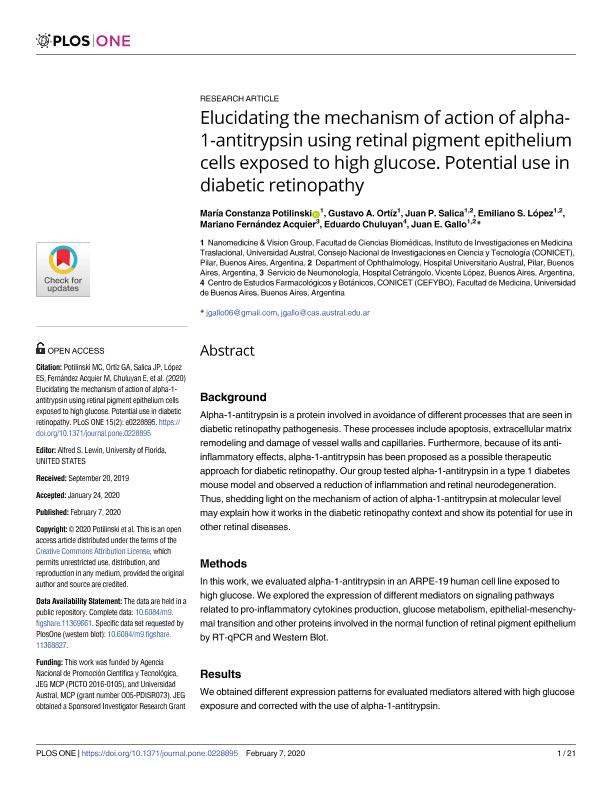Artículo
Elucidating the mechanism of action of alpha-1-antitrypsin using retinal pigment epithelium cells exposed to high glucose: Potential use in diabetic retinopathy
Potilinski, María Constanza ; Ortiz, Gustavo Alfredo
; Ortiz, Gustavo Alfredo ; Salica, Juan Pablo
; Salica, Juan Pablo ; Lopez, Emiliano Sebastian
; Lopez, Emiliano Sebastian ; Fernández Acquier, Mariano; Chuluyan, Hector Eduardo
; Fernández Acquier, Mariano; Chuluyan, Hector Eduardo ; Gallo, Juan Eduardo Maria
; Gallo, Juan Eduardo Maria
 ; Ortiz, Gustavo Alfredo
; Ortiz, Gustavo Alfredo ; Salica, Juan Pablo
; Salica, Juan Pablo ; Lopez, Emiliano Sebastian
; Lopez, Emiliano Sebastian ; Fernández Acquier, Mariano; Chuluyan, Hector Eduardo
; Fernández Acquier, Mariano; Chuluyan, Hector Eduardo ; Gallo, Juan Eduardo Maria
; Gallo, Juan Eduardo Maria
Fecha de publicación:
02/2020
Editorial:
Public Library of Science
Revista:
Plos One
ISSN:
1932-6203
Idioma:
Inglés
Tipo de recurso:
Artículo publicado
Clasificación temática:
Resumen
Background: Alpha-1-antitrypsin is a protein involved in avoidance of different processes that are seen in diabetic retinopathy pathogenesis. These processes include apoptosis, extracellular matrix remodeling and damage of vessel walls and capillaries. Furthermore, because of its anti-inflammatory effects, alpha-1-antitrypsin has been proposed as a possible therapeutic approach for diabetic retinopathy. Our group tested alpha-1-antitrypsin in a type 1 diabetes mouse model and observed a reduction of inflammation and retinal neurodegeneration. Thus, shedding light on the mechanism of action of alpha-1-antitrypsin at molecular level may explain how it works in the diabetic retinopathy context and show its potential for use in other retinal diseases. Methods: In this work, we evaluated alpha-1-antitrypsin in an ARPE-19 human cell line exposed to high glucose. We explored the expression of different mediators on signaling pathways related to pro-inflammatory cytokines production, glucose metabolism, epithelial-mesenchymal transition and other proteins involved in the normal function of retinal pigment epithelium by RT-qPCR and Western Blot. Results: We obtained different expression patterns for evaluated mediators altered with high glucose exposure and corrected with the use of alpha-1-antitrypsin. Conclusions: The expression profile obtained in vitro for the evaluated proteins and mRNA allowed us to explain our previous results obtained on mouse models and to hypothesize how alpha-1antitrypsin hinder diabetic retinopathy progression on a complex network between different signaling pathways. General significance This network helps to understand the way alpha-1-antitrypsin works in diabetic retinopathy and its scope of action.
Archivos asociados
Licencia
Identificadores
Colecciones
Articulos(IIMT)
Articulos de INSTITUTO DE INVESTIGACIONES EN MEDICINA TRASLACIONAL
Articulos de INSTITUTO DE INVESTIGACIONES EN MEDICINA TRASLACIONAL
Citación
Potilinski, María Constanza; Ortiz, Gustavo Alfredo; Salica, Juan Pablo; Lopez, Emiliano Sebastian; Fernández Acquier, Mariano; et al.; Elucidating the mechanism of action of alpha-1-antitrypsin using retinal pigment epithelium cells exposed to high glucose: Potential use in diabetic retinopathy; Public Library of Science; Plos One; 15; 2; 2-2020; 1-21
Compartir
Altmétricas



